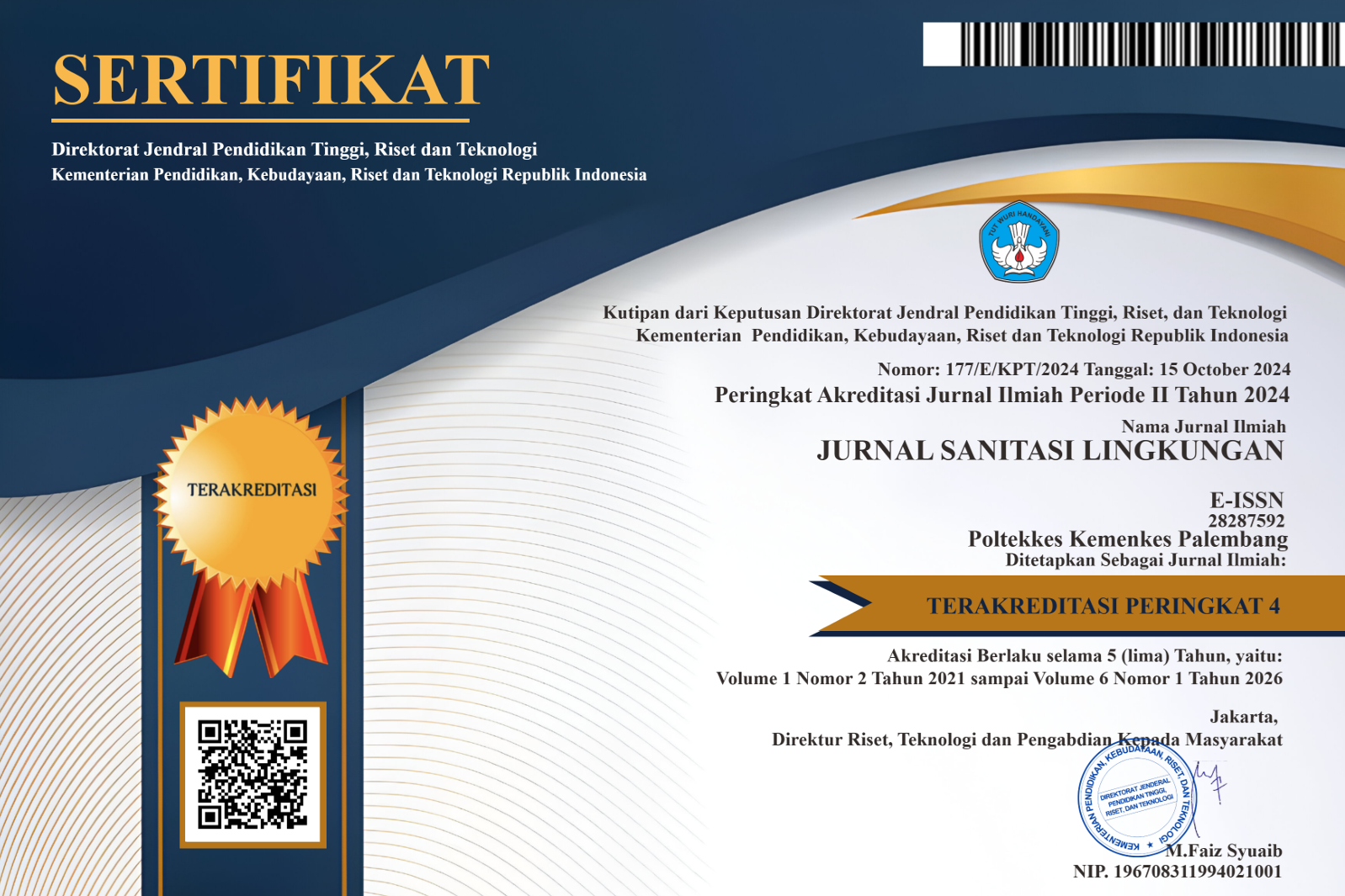Author Guidelines
Journal of Environmental Sanitation is published 2 (two) times each year (May and November ) publishes research-based articles and literature-based papers on Environmental Health, diseases related to the environment, public health, articles uploaded are articles that have never been published before, and will never be published in whole or in part in a print/online version elsewhere.
Completely written articles according to the article template
Guidelines for Registering an Environmental Sanitation Journal Account
Writing guide:
The title is written in Indonesian and English with a maximum of 15 words without including the year. The title is made clear, concise and attractive (Center, Times New Roman font 12, space 1)
Author's name is written: First Author, Second Author, Third Author
Affiliation: Name of Institution, Province, Country
(correspondence author email: rieweh@melatiputih.ac.id)
ABSTRACT
Background: This template is a guide format for writing articles in the Environmental Sanitation Journal which has been adapted to the environmental style of the Environmental Sanitation journal. All authors must follow the instructions provided in this guide. This document can be used as a reference in writing your manuscript. Make sure not to change the style existing in this template, including the type and size of the font, amount of spacing, indent spacing, and so on. The maximum number of pages for the Environmental Sanitation journal is 8 pages. background (1-2 sentences), research objectives (1 sentence). Write an abstract of a maximum of 250 words in Indonesian and English, letters using Times New Roman 11 points, 1 space.
Method: materials and methods are written in 3-5 sentences.
Results: research results are written in 3-5 sentences.
Conclusion: conclusion is written in 1 sentence made in 1 (one) paragraph.
Keywords: Minimum of 3 words, maximum of 5 words (capital letters are only found in the first keyword, separated by commas and not ending with a full stop on the last keyword.
INTRODUCTION
The introduction contains the background of the research problem described by the inverted pyramid method starting from the global, national and local levels. Include references (relevant literature or research results) using the source number in each sentence after a full stop (.) adapted to the Bibliography, for example:………..The results of the study reported that the incidence of anemia in pregnant women in the working area of Public Health Center A Kota Palembang as many as 25 cases.
The number of pages in the introduction is 1-1.5 pages or 3-5 paragraphs, each paragraph begins with a word that is indented into 5 digits. The final part of the introduction includes the research objectives. Introduction written using Times New Roman 11 point (upright) with 1 space
MATERIALS AND METHODS
This section explains the type and research design, location and time of research, population and sample, sampling techniques, data collection techniques, data analysis, and data presentation. Research that uses tools and materials, needs to write down the specifications of the tools and materials used. Qualitative research such as case studies, phenomenology, ethnography, and others, need to add a description of checking the validity of research results. Writing using Times New Roman 11 point (upright) with 1 space.
Paragraphs begin with words that are indented into 5 digits and may not use writing organization into sub-headings in this section, displayed in 1-2 paragraphs.
RESULTS
The results of the study describe the characteristics of the research subjects, univariate analysis, bivariate analysis and multivariate analysis (if any). Interpretation of research results is made in narrative form, tables and figures are made at most 3 Tables / Figures. Writing using Times New Roman 11 point (upright) with 1 space. Paragraphs begin with a word that is indented into 5 digits and may not use writing into sub-chapters for each variable.
Table 1. Table Format (According to the article template)
The discussion contains reasons that explain the results of research and other studies that support and are not in line with the research results obtained. It is not permissible to repeat sentences on the interpretation of the tables and graphs of the analysis results, but the results can be grouped to be interpreted and discussed based on the theory and results of previous research. Write using Times New Roman 11 point (upright) with 1 space. Paragraphs begin with a word that is indented into 5 digits and may not use writing organization into sub-headings for each variable.
CONCLUSIONS AND RECOMMENDATIONS
The conclusion contains a brief and clear description of the results and discussion with reference to the research objectives. Suggestions are prepared based on the research findings that have been discussed. Suggestions can refer to practical actions, development of new theories, and/or further research. Writing conclusions and suggestions using Times New Roman 11 point (upright) with 1 space. Paragraphs begin with a word that is indented into 5 digits and may not use numbering. And displayed in 1 paragraph.
ACKNOWLEDGEMENT
If necessary, thanks can be given to: parties who provide financial assistance and support, support from departments and institutions, and those who contributed to the preparation of the report.
REFERENCES
References is written according to the writing rules Vancouver, All references used in writing in references are numbered sequentially according to their appearance in the article. Only include the literature used and relevant. Reference sources of at least 80% are literature published in the last 10 years. Reference sources in the form of journals from articles of at least 60% of the total bibliography. The references used are primary sources in the form of research articles in journals or research reports, related books or articles from official sources. To maintain consistency in the way of referring, citing and writing a bibliography, we recommend using standard reference applications such as Endnote, Mendeley, Zotero, RefWorks or Colwiz.













